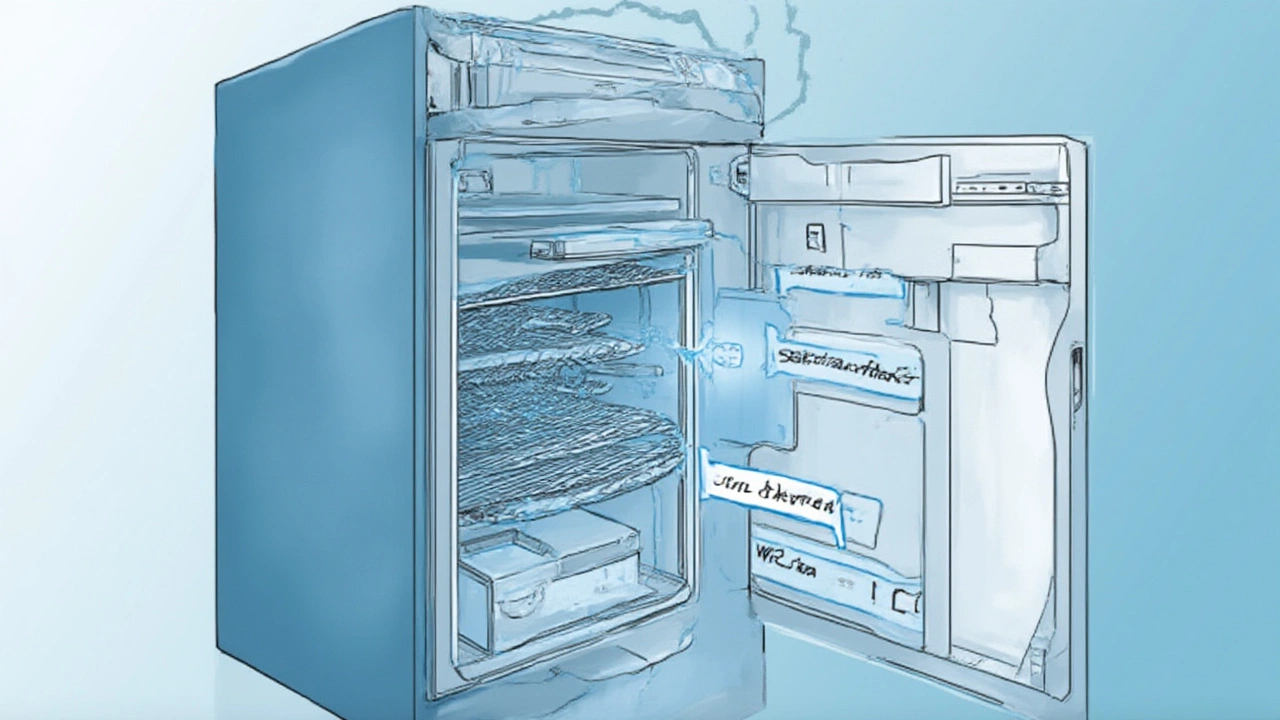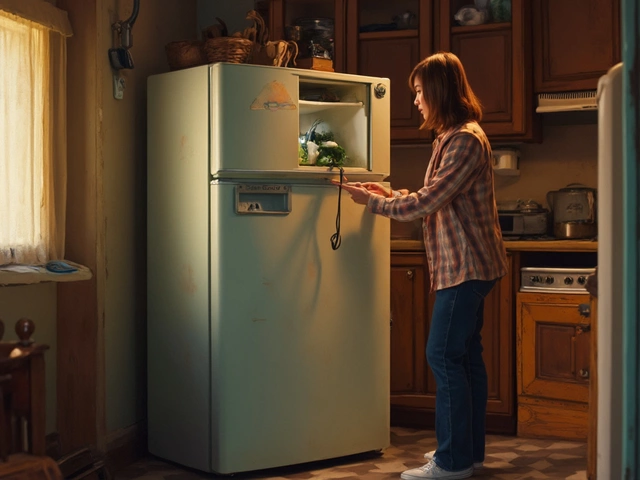Picture this: it's Sunday evening in Bristol, you pop the fridge open to grab milk for tea, and a wave of warm air hits you. Your food's sweating. The butter's gone soft. Nobody wants to think about buying a new fridge, especially when most issues are far easier to fix than you'd expect. But how do you even begin to diagnose the problem? Let's break down the clues, hunt for the sneaky faults, and figure out what your fridge is trying to tell you.
Spotting the Signs: Weird Noises, Leaks, and Clues
Your refrigerator is louder than a rock concert. Or maybe it’s developed a puddle that’s clearly not going away. These odd behaviours aren’t just quirks—they’re SOS flares. Diagnosing fridge problems starts with noticing what’s unusual.
If your fridge is clicking, buzzing, or rattling, don’t worry yet. Most fridges make some noise as they age. It’s the sudden changes that are suspicious. If you hear banging or constant clicking, for example, it could be the compressor relay failing—a super common issue in older fridges. I’ve seen this in models over seven years old, especially the cheaper, “budget” ones.
Leaks are a dead giveaway too. If there’s water pooling inside, check the defrost drain hole. These get blocked so easily—pet hair, bread crumbs, a stray piece of lettuce. Use a flexible straw or a pipe cleaner to push the gunk through. If water pools outside, look under the fridge: a cracked drain pan or loose water line are top suspects, especially if your fridge dispenses water or has an ice maker.
Strong chemical smell? Unplug the fridge. This could point to a refrigerant leak. In the UK, the newer fridges use R600a (isobutane) which has a faint chemical smell and is flammable, so don’t mess about—get a pro if you suspect this. Luckily, these leaks are rare in modern systems.
And don’t forget the classic: food spoiling before its time. If dairy is sour or greens wilt in days, the cooling could be faulty even if the fridge feels cold to the touch. Use a fridge thermometer, keep it between 2°C to 4°C. If it’s higher, your fridge is slacking off.
Here’s a quick cheat sheet to match symptoms and likely causes:
| Symptom | Possible Cause |
|---|---|
| Loud Clicking | Compressor relay issue |
| Constant Running | Dirty condenser coils or door seal problem |
| Warm Fridge, Cold Freezer | Evaporator fan blocked or broken |
| Pooling Water | Blocked drain hole or faulty water line |
| Ice Build-up | Defrost system failure |
Going Hands-On: Checks, Tools, and First Steps
Your first job is always to unplug the fridge before poking around insides. Electricity and puddles are a bad mix. Now, let’s cover what you can check with basic tools and no specialist training.
Start with the obvious: the power supply. Is the plug loose? Has the fuse tripped? It happens more than you’d think, especially in older Bristol flats with tricky wiring.
Next, pull the fridge out and look at the coils at the back or underneath. Over 80% of common fridge cooling problems are due to dirty, dusty condenser coils. When these are clogged, the compressor can overheat or the whole cooling process slows. Use a vacuum and a long brush (Amazon sells brushes called “coil brushes” for under a fiver). Clean those coils every six months—even more if you’ve got pets. Fun fact: tests by Which? in 2022 proved that cleaning coils can reduce power consumption by 10% and improve cooling noticeably within an hour.
Check the door seals, too. If you notice condensation around the seals, or if you spot cracks and splits in the rubber, the cold is leaking out and your fridge is overworking to compensate. Try the banknote test: trap a note in the door and pull. If it slides out easily, your seals are tired and need replacing. These kits aren’t expensive and, honestly, swapping them is a solid DIY job.
Now, let’s peek inside. Frost build-up on the back wall of your fridge or inside the freezer usually points to a defrost system issue. Older fridges use mechanical timers, while newer ones rely on electronic sensors and defrost heaters. If the ice is serious (over 1 cm thick), switch the fridge off for 24 hours and let the ice melt. Have towels handy. If the problem returns within a week, the automatic defrost system is probably the culprit and might need a new timer or thermostat sensor.
No lights on inside the fridge? Check the interior bulb—it’s usually straightforward to swap. If the bulb is fine, try a different plug socket just in case.
Here’s a step-by-step guide to the basics:
- Unplug the fridge and slide it out.
- Vacuum or brush the coils.
- Check the power plug and socket.
- Inspect door seals for gaps.
- Clear the defrost drain hole (inside, at the back of the fridge).
- Use a thermometer to check the temperature.
- Defrost manually if there’s heavy ice build-up.
If you follow these steps and things don’t improve, the problem might be electrical or involve sealed system parts—more on that in a bit.

Understanding What’s Under the Hood: Parts, Stats, and Common Fails
Fridges run on a surprisingly simple process: they move heat from inside to outside, thanks to a few key parts—a compressor, evaporator and condenser coils, thermostats, and a few fans. When even one piece goes wonky, stuff hits the fan (sometimes literally—broken fans are noisy!).
The compressor is like the heart. If it’s dead quiet but the lights come on, this could be trouble. Compressors rarely fail before ten years unless the coils haven’t been cleaned or there’s an electrical surge. When they go, they can sometimes cost half the price of a new fridge.
Evaporator and condenser fans keep the cold air moving and whisk excess heat away. When they break, you’ll often hear chirping or whirring coming from behind the fridge or inside the freezer. You can carefully spin these fans with a chopstick or pencil (with the fridge off). If they aren’t spinning freely or are noisy, replacements are available for most brands online. Just remember to match the part number—Spares2Repair is a solid UK site for hunting down exactly what you need.
Let’s talk electronics. Modern fridges (made after 2015) are smarter but sometimes erratic. Control boards can make bizarre things happen—random beeping, self-defrosting at odd times, or ambient lights flickering. If you see blank displays and your fridge isn’t working, try unplugging for 5 minutes. This can force a factory reset. No change? The control board could be shot.
Thermostats and sensors can drift over time. If your fridge is running but the temperature keeps creeping up and down, or if the fridge compartment warms up when the freezer stays icy, suspect a dodgy thermostat or a stuck damper door. Both are usually replaceable with a Phillips screwdriver, and loads of YouTube guides exist for every model under the sun.
Here's some UK fridge facts to keep things in perspective:
| Part | Usual Lifespan | Replacement Cost (GBP, Average) |
|---|---|---|
| Compressor | 10-15 years | £160-£300 |
| Evaporator Fan | 7-12 years | £40-£90 |
| Control Board | 5-9 years | £80-£180 |
| Door Seals | 4-8 years | £20-£40 |
| Thermostat | 6-10 years | £15-£50 |
Europe, including the UK, now has tougher energy standards for appliances thanks to 2021 EcoDesign rules. It means parts are more standardized and often easier to swap than they were a decade ago. Even big shops like Currys or John Lewis often keep basic spares in stock.
Knowing When to Call a Pro (and When to Throw in the Towel)
If your fridge is under warranty (usually two years for new models in the UK), don’t attempt any repairs that involve opening panels or wires—call the retailer or manufacturer. For everyone else, knowing your limits is a badge of honour, not a defeat.
If you smell burning, see smoke, or touch parts that are painfully hot, switch off the fridge and get on the phone. Compressor or sealed system repairs need tools and refrigerant–venting licenses; these aren’t meant for DIY jobs. Also, UK law requires all refrigerant work to be done by certified engineers, so don’t try to save a quid with shortcuts. Most Bristol-based repair shops can diagnose and quote within a day or two, and some will even deduct diagnostic fees from repair bills if you move forward.
Doing the maths on repair vs replacement? Here’s a rule of thumb, straight from the British Standards Institution: if repairs cost more than half the price of a new equivalent model, it’s usually better to get a new fridge. The energy efficiency upgrades alone, especially for old, humming beasts from the 2010s, save enough on bills to pay for the new one faster than you'd expect. Last winter, a Which? survey found the average new fridge-freezer costs £35 a year to run—half of what it was a decade ago.
If you do replace, check Bristol City Council recycling guidelines. Many retailers will haul away your old fridge for a small fee, ensuring the refrigerants and metals get handled properly (not fly-tipped down the Avon Gorge, thanks!).
To wrap up, diagnosing fridge faults isn’t as mysterious as it might seem. Watch for weird noises, leaks, and food going off. Get your hands dirty checking seals, cleaning coils, and watching the temp. When it’s beyond you, don’t risk your safety—call in the pros. A running fridge is the silent workhorse of our kitchens, and with a bit of savvy, you can keep it chilling for well over a decade. Easy as that, mate.




